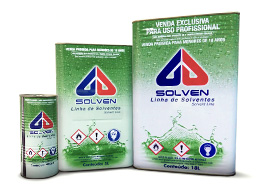
Solvenpar L Specification and Safety Information
DESCRIPTION
It is a colorless, high purity, hydrogenated and odorless liquid. The solvent has low reactivity and toxicity. Low levels of olefins, volatile organic and aromatic compounds, characterizing a greater chemical stability compared to aliphatic solvents. Composed mainly of isoparaffinic hydrocarbons.
PROPERTIES
See the tests, specification, Solven method and reference method in the PDF file available for download.
APPLICATION / MAIN USES
It is used in chemical processes such as degreasers, domestic and industrial detergents, insecticide formulations, printing inks, automotive products, water treatment chemicals. It is used as a fluid for the formulation of Protective Oil.
PACKAGING, STORAGE AND HANDLING
Product must be kept away from sources of ignition, in a cool, dry place, protected from bad weather. The shelf life of this product is 36 months from the date of manufacture, under the recommended conditions of storage and/or original packaging.
CLASSIFICATION FOR TRANSPORT
Product not classified according to current transport legislation.
ADOPTED CLASSIFICATION SYSTEM
Standard ABNT-NBR 14725-Part 2: 2009. Adoption of the Globally Harmonized System for the Classification and Labeling of Chemicals, UN.
STORAGE
P402+P403+P404 Store in a dry place. Store in a well-ventilated place. Store in a closed container.
PHYSICAL AND CHEMICAL PROPERTIES
Aspect:
- Physical state: Liquid;
- Appearance: Clear;
- Color: Colorless.
Odor: Low odor, but characteristic of hydrocarbons.
Odor threshold: Not Applied.
pH: Not Applied.
Melting point/freezing point: – 49 °C.
Initial boiling point and boiling temperature range: 179 – 213 °C.
Flash point: min. +61 °C (Closed Vessel).
Evaporation rate: 0.03 (Butyl Acetate = 1).
Flammability: Not Available.
Lower/upper limit of flammability or explosiveness: Upper (LSE): 5.5%, Lower (LIE): 0.6%.
Vapor pressure: 0.072 kPa (Ambient temperature).
Vapor density: 4.5 (Air = 1).
Relative density: 0.750 – 0.800 (water as standard).
Solubilities: Insoluble in water.
Partition coefficient – n-octanol/water: Not Applicable.
Auto-ignition temperature: > 220°C (ASTM E659-78).
Decomposition temperature: Not available.
Viscosity: On average 1.34 cSt at 40 °C (Kinematics).
STABILITY AND REACTIVITY
Reactivity: Not Available.
Chemical stability: Stable under normal conditions of use.
Possibility of Hazardous Reaction: Hazardous reactions do not occur under normal conditions of storage and use.
Conditions to Avoid: Heat, ignition sources, incompatible materials.
Incompatible materials: Oxidizing materials.
Hazardous decomposition products: On combustion, the formation of toxic decomposition products cannot be excluded.
TOXICOLOGICAL INFORMATION
Acute toxicity:
- Skin Corrosion/Irritation: Not available;
- Respiratory or skin sensitization: Not available;
- Germ cell mutagenicity: Not available;
- Carcinogenicity: Not Available;
- Reproductive toxicity: Not available;
- Specific target organ toxicity – repeated exposure: Not Available;
- Potential Acute Health Effects: Eye Contact – No known significant effects or critical hazards. Inhalation – No known significant effects or critical hazards. Skin Contact – Degreaser for skin. May cause skin irritation and drying. Ingestion – May be fatal if swallowed and enters airways;
- Symptoms related to the physical, chemical and toxicological characteristics: Eye contact – No specific data. Inhalation – No specific data. Skin Contact – Adverse symptoms may include the following: Irritation, Dry skin. Ingestion: Adverse symptoms may include the following: Nausea and vomiting.
ECOLOGICAL INFORMATION
Persistence and Degradability: Not available.
Bioaccumulative Potential: Not Available.
Ground mobility: Not available.
Other Adverse Effects: Not Applicable.
CONSIDERATIONS ON FINAL DESTINATION
Recommended disposal methods: This product can be reprocessed, incinerated in suitable facilities or sent for co-processing. Check in your Municipality and/or in your State, the applicable legislation on final disposal.
Used packaging: When the container is empty, contaminated with the product, it can be sent to drum recycling companies authorized by the environmental agency.